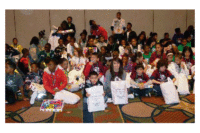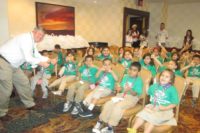Cracking the Kid/Candy Code
By Renee M. Covino
In order to be more kid-friendly in confections, it pays for retailers and manufacturers to understand how kids are changing — and how they remain the same.
Kids and candy
will always be a match, but there will also always be ways to strengthen
the bond. More than any other consumer segment, kids keep the confectionery
industry on its toes with their fickle, free-spirited, forever-changing
ideas on what´s “2 kewl” and what´s “not all
that.”
So why even bother getting to know them better?
Multiple industry studies show that marketing and merchandising efforts are
certainly not wasted on the young, which is shown to have an undeniable
(and building) spending power, no matter how research companies have
recently sliced it.
A Harris study reports that American kids, teenagers
and young adults, ages 8 to 21, have annual incomes (for kids, this
includes allowances and other “earned” money) totaling $211
billion and are actually spending 81.5 percent of it —which rounds
out to a nice $172 billion per year.
Futurist Jim Taylor, vice chairman of the Harrison
Group, separates the boys from the girls, proposing that boys under 18 have
an average of $525 to spend each month, while girls have $430.
Teenage Research Unlimited (TRU) puts the current U.S.
population of teens (ages 12 to 19) at 31.6 million; it also tracked the
group as spending $155 billion in 2005. What´s more, a recent TRU
study showed teens controlled an estimated $169 billion in disposable
income last year —which equates to an impressive $91 per week.
Alloy Media expects the number of teens to reach 35
million by 2010. It reports that the tween segment alone is spending $51
billion per year.
Jupiter Research calculates that teenagers spent over
$158 billion in 2005 and expects them to spend $205 billion in 2008.
What also gives more credence to this young consumer
group — kids´ money today is not all small bills and loose
change. Industry research highlights that 22 percent of U.S. teens have
credit cards while in high school.
And how they´re spending money isn´t all
that´s changing. Kids today are totally on top of technology, and
they´re more marketing-savvy than any generation before them. That
should, in turn, change the way marketers think about targeting/identifying
with them. Two main examples include:
They respond to more abbreviated messages. With email
and instant messaging part of their written culture, kids are turning in
homework and writing essays with abbreviated words and expressions carried
over from the shortened language of their electronic society. Even
elementary school children are participating in this writing form.
So it might help candy marketers to catch up on some of
this short language and use it in ads and certainly in online promotions.
Perhaps one of the most common ones used today is LOL for “laugh out
loud,” but others include: BRB for “be right back;” C-P
for “sleepy;” EM? for “excuse me?” J/C for
“just checking;” L8R for “later;” LMK for
“let me know;” NAZ for “name, address, zip code;”
RN for “right now;” and TOM for “tomorrow.”
More online abbreviations can be found/studied on
netlingo.com.
They are wired into fast information from multiple
sources. About 21 million, or nearly 87 percent of kids ages 12-17, are
online, many at least twice a day, according to a recent Pew Internet &
American Life study. That´s more than the activity of 25-to-29
year-olds, which have an 85 percent penetration. And 49 percent of teens
have high-speed connections at home, which is more than any other age
group.
Reaching them online should be a key goal for
marketers, but they have to realize that they won´t have their full
attention for very long. Kids are typically multi-tasking when
they´re online — doing homework, talking on the phone, texting,
sending emails, watching television, etc.
Messages from marketers, therefore, should be
short and sweet, and engage them without trying to “trick”
them. Kids are very aware of marketing gimmicks today, say the experts.
The same study from Pew also reported that nearly half
(49.3 percent) of the respondents play online games, which provide
marketers with a great vehicle for keeping kids in the marketing loop with
integrated product promotions called “advergames.”
How is the youth of today the same as it was in years
gone by? For one, kids are driven by imitation — meaning they still
want to look like and act like their friends, making purchases and favoring
brands that are popular, according to an independent retail consultant,
Linda Evans.
What´s more, well, that´s just it —
with most kids, “more is more,” believes Nita Rollins, a
marketing executive at the digital marketing agency Resource Interactive.
She says that tweens, especially, aren´t aware of “social codes
of restraint” and see no reason why they shouldn´t have every
flavor of a novelty candy, for example.
What´s in store for kids
When it comes to merchandising the kids´ candy
section, there are both traditional and new ways to keep it interesting,
according to the experts. Here are some of the category´s top
merchandising tips for retailers who aren´t afraid of attracting
loyal customers at a young age.
1. Create a destination where kids can go and shop candy.
“Kids´ candy should have a home in all retailers that have kids in their stores,” says Mike Cavalier, vice president of sales and marketing for Imaginings 3/Flix Candy. “The items should constantly be changing, but there should be a destination that anchors it.”
“Kids´ candy should have a home in all retailers that have kids in their stores,” says Mike Cavalier, vice president of sales and marketing for Imaginings 3/Flix Candy. “The items should constantly be changing, but there should be a destination that anchors it.”
2. Keep it at eye level.
“Make sure the kids´ candy is merchandised at a shelf level appropriate for the height of these consumers,” says Andy Telatnik, director of marketing for Impact Confections.
“Make sure the kids´ candy is merchandised at a shelf level appropriate for the height of these consumers,” says Andy Telatnik, director of marketing for Impact Confections.
3. Rotate at least 50 percent of the set every year with
as much choice as possible.
“Selection is a great thing for kid consumers,” maintains Laura King, vice president of marketing with Candy Dynamics. “For this reason, we have developed line extensions of our very popular kids´ candy brand, Toxic Waste Hazardously Sour Candy to reach the growing demand for different delivery methods of sours. What they want really matters to us, which is why this year we´ve launched a sour powder with lollipop, sour spray, and a sour chew bar.”
“Selection is a great thing for kid consumers,” maintains Laura King, vice president of marketing with Candy Dynamics. “For this reason, we have developed line extensions of our very popular kids´ candy brand, Toxic Waste Hazardously Sour Candy to reach the growing demand for different delivery methods of sours. What they want really matters to us, which is why this year we´ve launched a sour powder with lollipop, sour spray, and a sour chew bar.”
With this in mind, “the set should rotate new
items in every six to 12 months,” believes Cavalier.
4. Supplement the set with shippers and floor displays
featuring anchor and “topical” items.
Imaginings 3 is “constantly” adding to its line, according to Cavalier, and for the first half of this year was ready with a “very strong line-up on licensed (or topical) goods including Spiderman 3, Shrek the Third, Pirates of the Caribbean — At World´s End, and Ratatouille.
Imaginings 3 is “constantly” adding to its line, according to Cavalier, and for the first half of this year was ready with a “very strong line-up on licensed (or topical) goods including Spiderman 3, Shrek the Third, Pirates of the Caribbean — At World´s End, and Ratatouille.
“In the back half we will focus on new, everyday
candy items,” he adds. Retailers should be incorporating new
rotations from all these areas — line extensions, delivery systems,
“in and outs,” and everyday items.
5. Cross-merchandise with today´s kid shoppers in
mind.
Shipper power wings and floor displays also are useful sales tools for stores that recognize the value in featuring kids´ candy in other areas of the store, according to King. That could, of course, include the toy and cereal aisles, but kids are also interested these days in the offerings found in beverage and snack aisles, as well as more sophisticated areas such as blank media, school and computer supplies, books and magazines, photo finishing, and seasonal displays.
Shipper power wings and floor displays also are useful sales tools for stores that recognize the value in featuring kids´ candy in other areas of the store, according to King. That could, of course, include the toy and cereal aisles, but kids are also interested these days in the offerings found in beverage and snack aisles, as well as more sophisticated areas such as blank media, school and computer supplies, books and magazines, photo finishing, and seasonal displays.
“There is apparently a growing demand for
seasonal edible novelties,” according to Philip Brilliant, vice
president of A&A Global Industries.
6. Celebrate their seasons.
Seasonal candy sales from a kid´s perspective are a slightly altered version of adult holidays. For instance, youngsters are not typically in tune to Memorial Day as a holiday per se, but they do care about the fact that it marks the start of the summer season.
Seasonal candy sales from a kid´s perspective are a slightly altered version of adult holidays. For instance, youngsters are not typically in tune to Memorial Day as a holiday per se, but they do care about the fact that it marks the start of the summer season.
Retailers like Roundy´s set promotions around
“Candy Carnivals,” right around this time. Carnival signage and
a carved-out section “features kids´ candy as well as relevant
movie tie-ins for the big blockbusters of the year,” explains Mike
Overschmidt, candy category manager.
“Novelty candy has a strong summertime impact,
however, it also has a strong spring season as well,” adds Carol
Prior, director of sales and marketing for Kandy Kastle. “This could
be that families are on vacation and more likely to buy novelty candies and
that kids are more likely to be walking home from school when the weather
is warmer.”
7. Get nostalgic for parents and older kids.
Kids´ novelty candy is not often thought of as retro candy, but in the case of items like Topps´ Ring Pop — celebrating its 30th anniversary this year — it is one in the same.
Kids´ novelty candy is not often thought of as retro candy, but in the case of items like Topps´ Ring Pop — celebrating its 30th anniversary this year — it is one in the same.
Retailers who play up this fact within sets with
signage/promotions and/or a set-within-a-set will make a strong case for
parents to buy their child a favorite candy item from their past — as
well as entice teenagers to make a purchase, either for themselves or
younger siblings.
8. Speak their sign language.
Signage in the section should reflect the style and culture of today´s kids. Retailers that get to know images, colors and abbreviations that speak to them, either through kid Web sites, games or just good observation, will have the best chance of selling through on the section. This is perhaps the most fun area of the store — it should look and act like it — and be distinct from the “everyday” candy section of the stores.
Signage in the section should reflect the style and culture of today´s kids. Retailers that get to know images, colors and abbreviations that speak to them, either through kid Web sites, games or just good observation, will have the best chance of selling through on the section. This is perhaps the most fun area of the store — it should look and act like it — and be distinct from the “everyday” candy section of the stores.
9. Squeeze in some healthy snacks.
The most pressing issue in all of kids´ consumables today is health benefits, recognizes Brilliant. While low-fat, low-sugar and vitamin-infused kids´ candies are available, and when packaged right, can even be attractive to kids, they are really more successful with the parents.
The most pressing issue in all of kids´ consumables today is health benefits, recognizes Brilliant. While low-fat, low-sugar and vitamin-infused kids´ candies are available, and when packaged right, can even be attractive to kids, they are really more successful with the parents.
Therefore, it might also behoove retailers to
incorporate some “healthy” snacks such as mini trail mixes and
nuts, right within the set. Some alternative retailers such as
Michael´s are doing this, specifically to attract moms to the section
and perhaps have them linger just a bit longer, not only for the sake of
their children´s treat selection, but perhaps so they can pick up a
snack for themselves.
10. Have as much fun designing/creating the section as you
want the kids to have browsing it.
Sure there are clean-up and maintenance issues with anything having to do with kids, according to experts like Bill Berkowsky, customer marketing manager at Topps. “But ultimately it should be fun. Just do it, good merchandising grows this business,” he says.
Sure there are clean-up and maintenance issues with anything having to do with kids, according to experts like Bill Berkowsky, customer marketing manager at Topps. “But ultimately it should be fun. Just do it, good merchandising grows this business,” he says.




